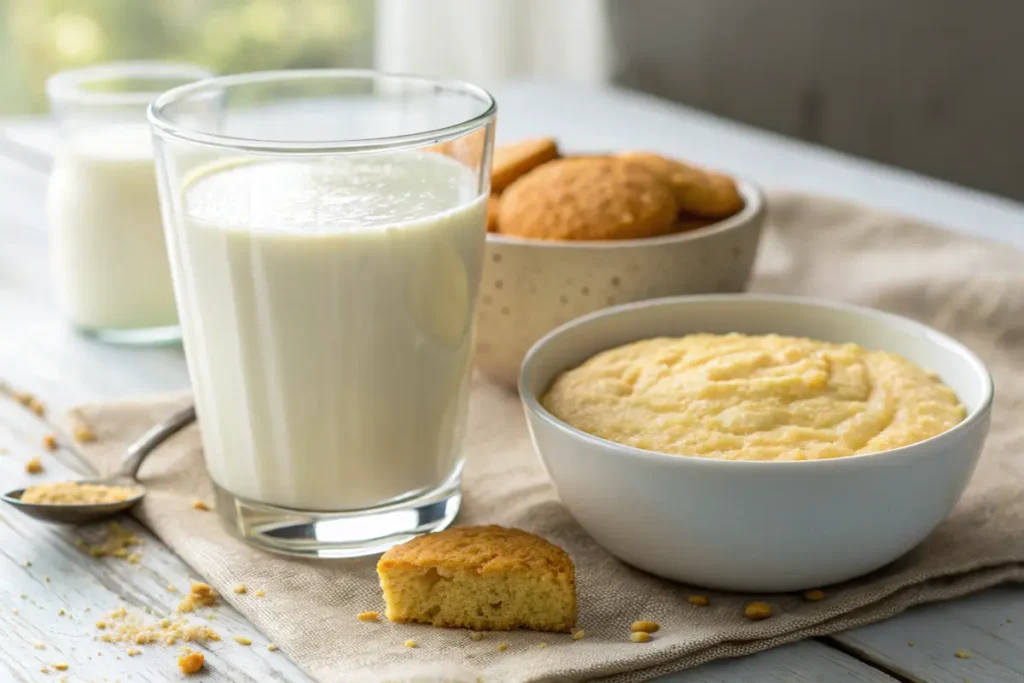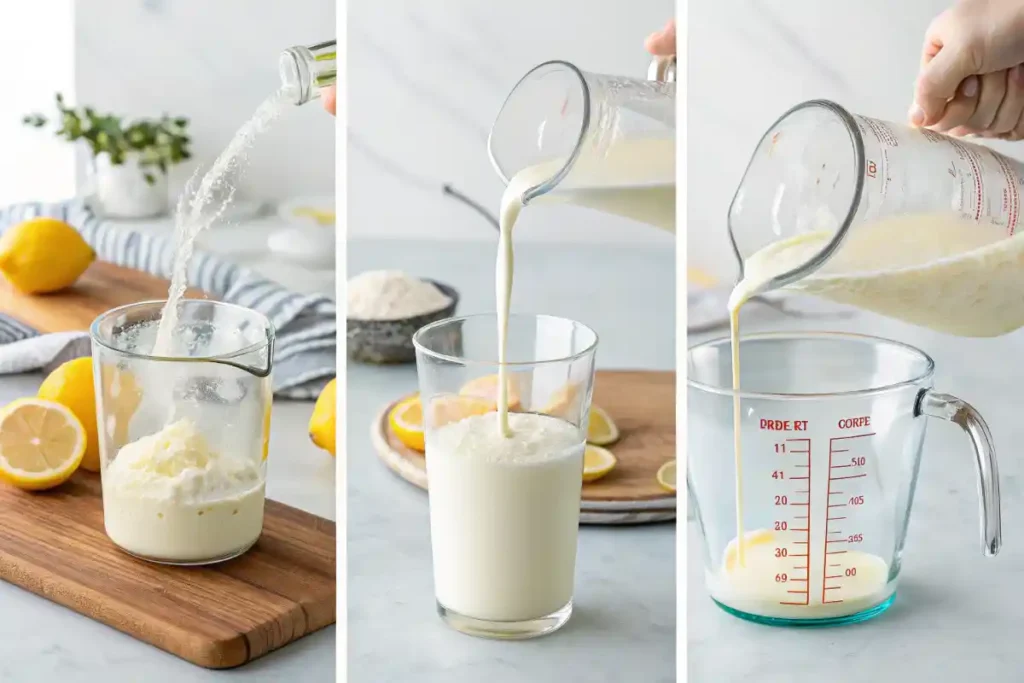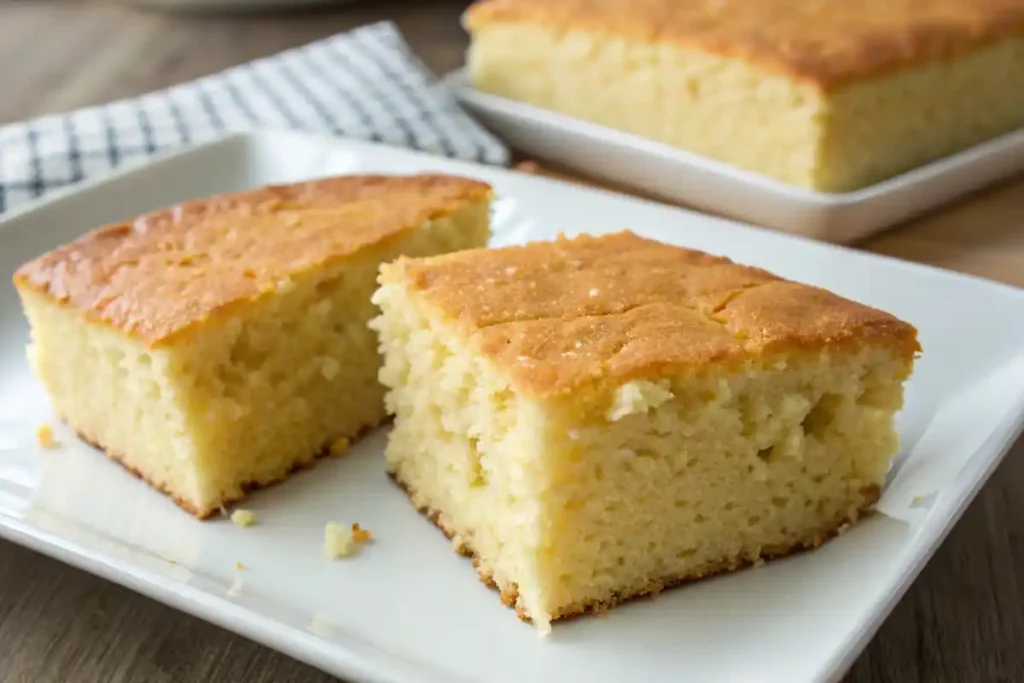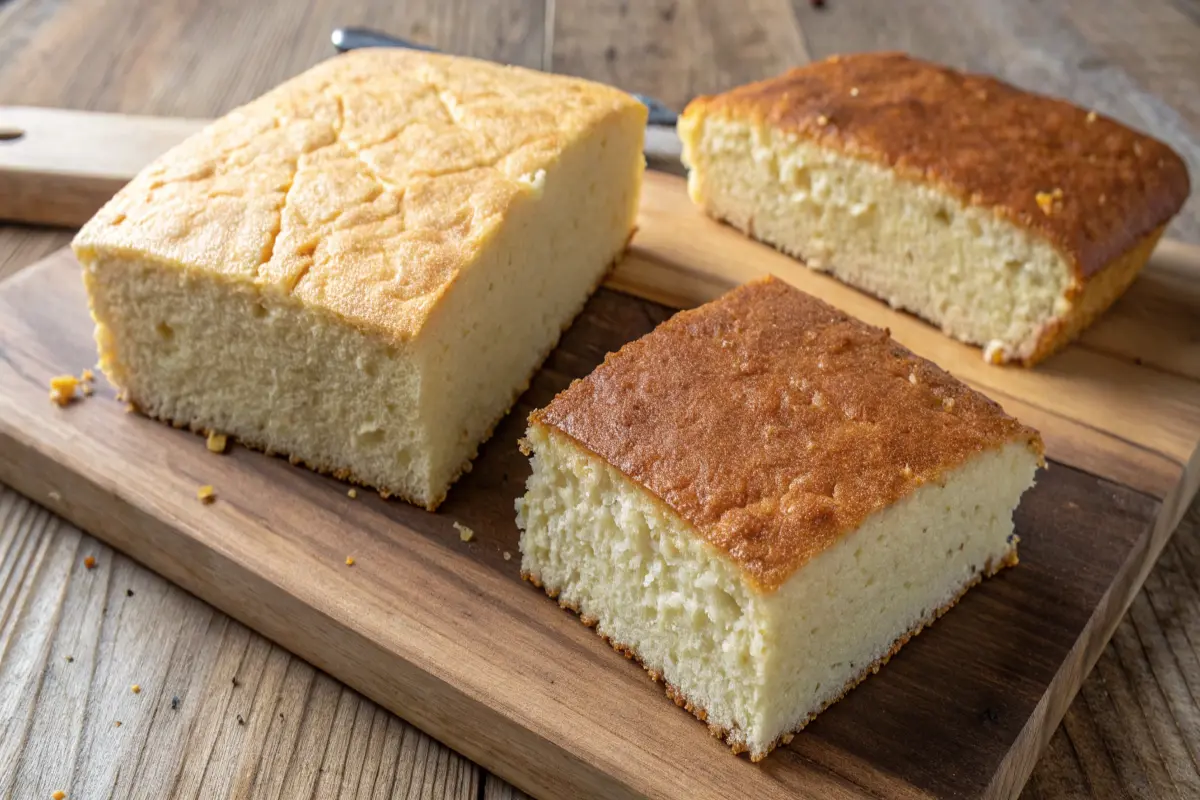The humble cornbread—a staple across many cultures, especially in the American South— might seem simple, but behind its golden crust lies a surprisingly complex world of ingredient choices. One of the most frequent questions that pops up when making this beloved bread is this: is it better to use milk or buttermilk in cornbread? It’s a debate that has sparked many a kitchen conversation, and for good reason. The liquid you choose significantly impacts the texture, flavor, and overall success of your cornbread.
This article dives deep into this debate, helping you decide which option works best for your cornbread cravings. We’ll be exploring the nuances of both milk and buttermilk, from their composition to their effects on the final product. So, whether you’re a seasoned baker or a cornbread newbie, let’s get started, shall we?
Introduction: The Cornbread Conundrum
A Timeless Debate: Milk or Buttermilk?
Cornbread. Just the word conjures images of warm, golden squares served alongside hearty meals. It’s more than just a bread; it’s a comfort food, a cultural touchstone, and a testament to simple ingredients transformed into something truly special. However, for such a seemingly straightforward recipe, the choice of liquid—specifically, whether to use milk or buttermilk—can make all the difference. Is it better to use milk or buttermilk in cornbread? This question often leads to spirited discussions among home cooks.
Briefly introducing the popularity of cornbread
Let’s face it, cornbread is seriously popular. From fancy restaurants to casual potlucks, this dish has found its way into hearts and onto plates everywhere. Its versatility is just one reason for its widespread appeal. Cornbread can be sweet, savory, crumbly, or dense; it is a real chameleon of a side dish. Its charm comes not only from its simplicity but also from the many ways it can be adapted to suit any palate or occasion.
Setting the stage for the milk vs. buttermilk debate
Now, when we talk about making cornbread, the question inevitably arises: what about the liquid component? Many recipes call for either milk or buttermilk, but these two aren’t interchangeable. The truth is, they bring different things to the table. We’re about to embark on a journey to explore these differences.
Why the liquid matters: the role of moisture in cornbread texture
The type of liquid you use is not just about adding moisture; it’s about the magic that happens behind the scenes. The liquid interacts with the dry ingredients, affecting the overall structure of the cornbread. Think of moisture as the glue holding everything together. It contributes to the texture, the crumb, and even the final flavor. Therefore, the decision of milk or buttermilk is super significant.
Briefly touching upon the expected outcomes of using milk vs. buttermilk
So, what can you expect when choosing milk versus buttermilk? Milk generally yields a milder flavor and a somewhat denser texture, whilst buttermilk, on the other hand, typically produces a tangier flavor and a more tender crumb. But, this is just scratching the surface. The devil is really in the detail, and we’ll certainly dig deeper into this as we go.
Understanding the Basics: Milk in Cornbread

What Does Milk Contribute to Cornbread?
First, let’s look at milk. As a common household staple, it’s a frequent choice for baking, but what exactly does it bring to the cornbread party? Well, milk is essentially a combination of water, fat, and lactose (a type of sugar). These components play very distinct roles. Firstly, the water content is crucial for hydrating the dry ingredients, like the cornmeal and flour. Secondly, the fat, regardless of whether it’s whole, 2%, or skim milk, contributes to the overall moistness of the final product. Finally, the lactose adds a subtle touch of sweetness, which is a big part of why milk is preferred by some.
The Impact of Using Regular Milk in Cornbread
When you use regular milk in your cornbread, you can expect a specific texture and flavor profile. Generally, the cornbread will be a little denser and more compact with a finer crumb. The flavor, while pleasant, tends to be subtly sweet and milky, without the characteristic tanginess that you get with buttermilk. In addition, the fat content in the milk affects the final result. Whole milk, naturally, will lead to a richer cornbread than skim milk, which might end up a bit drier.
Variations in Milk: Whole, 2%, Skim
Now, it’s worth noting that not all milk is created equal. The different fat percentages in whole, 2%, and skim milk affect the outcome of your cornbread. Whole milk, with its higher fat content, will result in a richer, more tender cornbread. On the other hand, 2% milk strikes a balance between richness and lightness, whilst skim milk tends to produce a drier cornbread because of its minimal fat content. Therefore, if you’re using milk, whole or 2% are usually your better bets.
Advantages and Disadvantages of using Milk in Cornbread
All things considered, using milk in cornbread has both its advantages and drawbacks. On the plus side, it’s readily available, super affordable, and most people are already familiar with its taste. However, milk-based cornbread can sometimes turn out less tender, and a tad flatter than its buttermilk counterpart. That said, it’s still a really delicious option when that’s all you have! However, this brings us to the main question: is it better to use milk or buttermilk in cornbread? To answer this, we need to explore the magic of buttermilk next.
Exploring the Tangy World of Buttermilk in Cornbread
What is Buttermilk and How Does It Differ From Milk?
So, let’s talk about buttermilk. Unlike regular milk, buttermilk isn’t simply the liquid left after churning butter anymore, as it was back in the day. Instead, what we buy at the store is cultured buttermilk, which is created by adding lactic acid bacteria to milk. This process gives buttermilk its unique tangy flavor and its thicker consistency. The key difference lies in the lactic acid, which plays a critical role in the baking process, impacting both the flavor and texture of cornbread.
How Does Buttermilk Impact the Texture and Flavor of Cornbread?
The effect of buttermilk on cornbread is pretty remarkable. The lactic acid does more than just add that distinct tang; it actually tenderizes the gluten in the batter, resulting in a far more tender and moist crumb. Furthermore, the acidity in buttermilk interacts with leavening agents like baking soda, helping the cornbread to rise higher and giving it a lighter, more airy feel. That tangy flavor is pretty awesome too, adding another layer of complexity to the final result. Indeed, the use of buttermilk helps create a more satisfying cornbread.
Using Buttermilk in cornbread: Advantages and Disadvantages
Alright, let’s weigh the pros and cons of using buttermilk in cornbread. First of all, the advantages are pretty clear: a tangier, more complex flavor, and a superior texture, with a more tender crumb and a higher rise. Plus, the baking soda is fully activated with buttermilk’s acidity. However, buttermilk isn’t without its downsides. For starters, it might not be as readily available as regular milk in some areas, or it might be pricier. Additionally, not everyone likes its unique tangy taste. But, if you’re a fan of that flavor, there’s no doubt that it’s the best option.
How to Make a Buttermilk Substitute

Now, if you don’t have buttermilk on hand, don’t fret. There is a simple buttermilk substitute that works almost as well. You can easily make a pretty decent stand-in at home. Simply add a tablespoon of lemon juice or white vinegar to a cup of milk. Let the mixture sit for about 5-10 minutes, allowing it to curdle slightly. This method adds a bit of that needed acidity, which will help in the baking process. This substitute is a good option when you’re in a bind and, therefore, a good solution to the question of is it better to use milk or buttermilk in cornbread, when you don’t have the buttermilk.
A Side-by-Side Comparison: Milk vs. Buttermilk in Cornbread Recipes

Side-by-Side Analysis: Visual, Flavor and Texture Comparison
So, let’s put milk and buttermilk head-to-head in a real-world cornbread scenario. When you bake two batches side-by-side, one using milk and the other using buttermilk, you’ll start to see some notable differences. The milk-based cornbread tends to have a more uniform golden color, a tighter crumb structure, and it will often be flatter. On the other hand, the buttermilk-based cornbread usually exhibits a more golden-brown color and a more varied texture with a slightly more open crumb. The smell is also different, as buttermilk will give the cornbread that beautiful tang.
When it comes to the texture, the milk cornbread can feel somewhat denser and perhaps a little drier than the one with buttermilk. Buttermilk contributes to a softer, more moist, and airy texture, that many people find much more satisfying. Finally, when you take a bite, the flavor of milk cornbread is generally mild and subtly sweet, while buttermilk delivers that distinctive tangy flavor, making it a little more interesting. Is it better to use milk or buttermilk in cornbread? The side-by-side analysis should give a better understanding of which option is better depending on one’s preferences.
Recipe Adaptations for Milk and Buttermilk
Furthermore, it’s crucial to understand that you might need to tweak your cornbread recipe slightly depending on whether you’re using milk or buttermilk. If you’re using milk, you might want to add a bit more fat (like melted butter or oil) to help keep the cornbread moist. You could also consider adding a touch of extra baking powder to help it rise a bit better, as milk won’t activate the baking soda as effectively as buttermilk does.
On the other hand, if your recipe calls for buttermilk, make sure not to over mix the batter, as this can lead to a tough cornbread. Because of its higher acidity and reaction with baking soda, you might not need as much baking powder. Therefore, knowing how these two behave in a recipe is the key to success.
Best Scenarios for Using Milk or Buttermilk in Cornbread
So, when should you choose milk and when should you go for buttermilk? In general, if you’re going for a milder flavor and you don’t mind a slightly denser texture, milk is a good and safe bet. It’s also perfect if you’re making a simpler, everyday cornbread or if you are on a budget. However, if you’re aiming for a more tender, tangy, and flavorful cornbread, and a more open crumb, buttermilk is definitely the better option. It’s also preferred when you want that classic Southern-style cornbread. Therefore, your preference should inform your decision.
Other Factors Affecting Cornbread Success
Cornmeal Matters: Different Types and Their Impact
It is important to remember that milk and buttermilk are not the only elements to consider when making cornbread. The type of cornmeal you use also plays a crucial role in the final result. Cornmeal comes in different grinds: fine, medium, and coarse. Fine ground cornmeal will result in a smoother cornbread, whereas a coarse ground cornmeal will result in a more textured, rustic cornbread. Additionally, the kind of cornmeal will affect the overall level of moisture and baking time.
The Significance of Fat: Butter, Oil, or Lard?
Furthermore, the kind of fat you choose is also significant. Whether you use melted butter, vegetable oil, or even lard, each option brings something different to the table. Butter adds a delicious richness and flavor. Oil is great for creating a moist texture, and lard, if you’re feeling traditional, can contribute to an incredibly tender and flavorful cornbread. Therefore, the choice is based on flavor and available ingredients.
Sweetness Preferences: Sugar or No Sugar?
The question of whether to add sugar to cornbread is a really polarizing one. Some people love a touch of sweetness, while others prefer their cornbread to be completely savory. Therefore, there is not a “right or wrong answer” here. It all comes down to personal preference and what complements the rest of your meal.
Baking Temperature and Time
Finally, achieving the perfect golden crust and ensuring that your cornbread is fully cooked through is all down to the baking temperature and time. Generally, baking at a moderate temperature is key, which gives the cornbread enough time to rise and cook through without burning. Therefore, be careful, and check the cornbread for doneness.
The Ultimate Choice: Which is Better, Milk or Buttermilk in Cornbread?
Recapping the key differences between milk and buttermilk
Let’s quickly recap the key differences we’ve covered. Milk, a familiar and readily available option, brings a subtle sweetness and contributes to a denser texture in cornbread. Buttermilk, on the other hand, provides a signature tanginess, a more tender crumb, and a superior rise, thanks to its acidity. It is also important to note that these differences, although significant, are dependent on one’s taste.
The final verdict: considering personal preferences
So, when it comes down to it, is it better to use milk or buttermilk in cornbread? Well, the honest answer is: it depends on your personal taste and preference. If you like a milder flavor and a more compact cornbread, then milk is totally fine! However, if you prefer that characteristic tangy flavor, plus a moister and fluffier texture, then buttermilk is the way to go. There isn’t a wrong answer; it’s all about what you enjoy most.
When to Opt for each liquid: practical recommendation
Therefore, if you’re looking for a quick and easy cornbread using ingredients you likely already have, then milk will do just fine. Yet, if you’re aiming for that classic, Southern-style cornbread that’s tender, flavorful, and slightly tangy, then buttermilk is absolutely worth the effort. The choice is yours!
Concluding thoughts: There is no wrong answer
In conclusion, the debate over milk versus buttermilk in cornbread is really a matter of taste and what you hope to achieve in your final product. Both will make a lovely loaf of cornbread, just in slightly different ways. Therefore, don’t be afraid to experiment and find what works best for you!
Frequently Asked Questions (FAQs) About Milk and Buttermilk in Cornbread
Advanced Techniques for Cornbread Perfection
Souring Milk: A Middle Ground?
Now, if you don’t have buttermilk and you want to get closer to that tangy flavor, there’s another little trick you can try: souring milk. By adding a teaspoon of lemon juice or vinegar to milk and letting it sit for 5 to 10 minutes, you can create a substitute that is a little closer to buttermilk in terms of acidity. This process helps to activate the baking soda better and also adds a subtle tang to your cornbread. Therefore, it can be useful.
Using Different Leavening Agents
Furthermore, the type of leavening agent you use also matters. While most cornbread recipes call for a combination of baking powder and baking soda, the proportion of each will affect the overall rise and texture. Buttermilk is best when used in conjunction with baking soda, as its acidity will activate the baking soda more effectively. But, if you are using regular milk, you might want to consider using slightly more baking powder. Therefore, you have to adjust the leavening based on the liquid.
Experimenting with Herbs and Spices
It’s also worthwhile to experiment with herbs and spices to enhance the flavor of your cornbread. Adding ingredients such as chives, rosemary, or even a pinch of chili powder can really elevate your cornbread. Is it better to use milk or buttermilk in cornbread when adding different herbs and spices? Well, both act as a vehicle for the new flavours, so it comes down to what is best to accompany it. For example, savory herbs and spices pair very well with a buttermilk base, but you will have to try out your flavour combinations and see what works best for you.
Resting the Batter: A Simple Tip
Another often-overlooked tip is letting the batter rest for about 10-15 minutes before baking. This allows the cornmeal to fully hydrate, which will contribute to a more moist and tender cornbread. Therefore, patience can also be key!
Final Thoughts and Quick Recipe Tips
The Importance of Quality Ingredients
Above all, remember that using high-quality ingredients makes a huge difference in the overall outcome. Fresh cornmeal, good butter, and fresh dairy products will elevate your cornbread, no matter which liquid you choose. So, don’t skimp on the details.
Quick Recipe Tips for Milk Cornbread
If you’re opting for milk in your cornbread, be sure to add some extra melted butter or oil for additional moisture. Also, adding a little extra sugar can enhance the flavor. Always use a slightly higher baking powder ratio when using milk. It will help it rise better.
Quick Recipe Tips for Buttermilk Cornbread
When using buttermilk, remember that a lighter hand is key. Don’t overmix the batter. You want that airy texture! And, don’t be afraid to experiment with a little bit of heat by adding a pinch of cayenne pepper or a dash of hot sauce.
The Joy of Cornbread Baking
Ultimately, baking cornbread should be an enjoyable experience. Whether you prefer a milk-based or a buttermilk-based cornbread, take the time to savor the process. And by now you know that the question of is it better to use milk or buttermilk in cornbread is really one for yourself to answer after experimenting with both. So, get creative, have fun, and happy baking!

